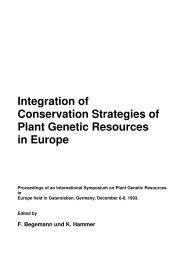Agrobiodiversität in Deutschland - Genres
Agrobiodiversität in Deutschland - Genres
Agrobiodiversität in Deutschland - Genres
Sie wollen auch ein ePaper? Erhöhen Sie die Reichweite Ihrer Titel.
YUMPU macht aus Druck-PDFs automatisch weboptimierte ePaper, die Google liebt.
122 | Dan Leskien<br />
Genetische Ressourcen für Ernährung und Landwirtschaft –<br />
<strong>in</strong>ternationale Entwicklungen<br />
programm der Kommission für genetische Ressourcen für Ernährung und<br />
Landwirtschaft vorgesehen. Der Weltzustandsbericht zur biologischen Vielfalt<br />
für Ernährung und Landwirtschaft soll 2017 vorgestellt werden.<br />
Globale Aktionspläne zur Erhaltung und nachhaltigen Nutzung der biologischen<br />
Vielfalt für Ernährung und Landwirtschaft müssen umgesetzt, und<br />
ihre Umsetzung muss systematisch beobachtet und evaluiert werden. Abstimmung<br />
auf <strong>in</strong>ternationaler Ebene ist notwendig, auch um die Erhaltung<br />
und nachhaltige Nutzung der biologischen Vielfalt als Leitbild von Landwirtschafts-<br />
und Umweltpolitik zu etablieren.<br />
Neue Instrumente wurden <strong>in</strong> jüngster Vergangenheit <strong>in</strong>sbesondere im Bereich<br />
der Regelungen zum Zugang und Vorteilsausgleich geschaffen. E<strong>in</strong>e<br />
sachadäquate, auch die Besonderheiten genetischer Ressourcen für Ernährung<br />
und Landwirtschaft berücksichtigende Implementierung dieser Regelungen<br />
bleibt e<strong>in</strong>e Herausforderung.<br />
Abstract<br />
Biological diversity for food and agriculture is one of the most important<br />
natural resources. This diversity is under threat. With the erosion of biodiversity,<br />
mank<strong>in</strong>d loses more and more the potential to adapt agriculture and<br />
food production to chang<strong>in</strong>g socio-economic and environmental conditions.<br />
No country is self-sufficient with regard to the genetic resources for food and<br />
agriculture it uses. Conservation, susta<strong>in</strong>able use and the fair and equitable<br />
shar<strong>in</strong>g of benefits aris<strong>in</strong>g out of the utilization of genetic resources therefore<br />
require global cooperation, as is <strong>in</strong>creas<strong>in</strong>gly recognized, and reflected by the<br />
<strong>in</strong>ternational developments.<br />
The preparation of reports on the state of the world’s biological diversity<br />
requires global cooperation and coord<strong>in</strong>ation. The Food and Agriculture Organization<br />
of the United Nations (FAO) recently published The Second Report<br />
on the State of the World’s Plant Genetic Resources for Food and Agriculture.<br />
Further reports cover<strong>in</strong>g other sectors (forest genetic resources, aquatic genetic<br />
resources) are scheduled <strong>in</strong> the Multi-Year Programme of Work (MYPOW) of<br />
the Commission on Genetic Resources for Food and Agriculture. The launch of<br />
“The State of the World’s Biodiversity for Food and Agriculture” is foreseen for<br />
2017.<br />
Global plans of action for the conservation and susta<strong>in</strong>able utilization of biodiversity<br />
for food and agriculture have to be implemented and implementation<br />
should be monitored and evaluated. At global level, coord<strong>in</strong>ation is needed to<br />
establish conservation and susta<strong>in</strong>able utilization of biological diversity as a<br />
general pr<strong>in</strong>ciple of agricultural and environmental policy.<br />
In recent years, new <strong>in</strong>struments have been developed, <strong>in</strong> particular <strong>in</strong> the area<br />
of access to genetic resources and benefit-shar<strong>in</strong>g. What rema<strong>in</strong>s a major challenge<br />
is the adequate implementation of these <strong>in</strong>struments which should take<br />
<strong>in</strong>to account the special features of genetic resources for food and agriculture.<br />
E<strong>in</strong>führung<br />
In den vergangenen 30 Jahren haben sich auf <strong>in</strong>ternationaler Ebene die<br />
politische Landschaft und auch der rechtliche Rahmen für die Erhaltung<br />
und Nutzung der biologischen Vielfalt erheblich verändert. Dies gilt <strong>in</strong> besonderem<br />
Maße für genetische Ressourcen für Ernährung und Landwirtschaft.<br />
Die E<strong>in</strong>richtung der FAO-Kommission für Genetische Ressourcen<br />
für Ernährung und Landwirtschaft (Kommission) im Jahr 1983 wie auch die<br />
Gründung des IBV 1982 markieren e<strong>in</strong>e wichtige Phase globaler beziehungsweise<br />
nationaler Institutionalisierung abgestimmter Bemühungen um die<br />
Erhaltung und nachhaltige Nutzung genetischer Ressourcen für Ernährung<br />
und Landwirtschaft.<br />
Mit neuen Instrumenten, wie dem Internationalen Vertrag über pflanzengenetische<br />
Ressourcen für Ernährung und Landwirtschaft, und Institutionen,<br />
wie der Kommission, wurde auf <strong>in</strong>ternationaler Ebene e<strong>in</strong>e wichtige Grundlage<br />
für die verbesserte Erhaltung und Nutzung genetischer Ressourcen<br />
geschaffen. Gleichwohl bleibt auch auf <strong>in</strong>ternationaler Ebene viel zu tun,<br />
um im Interesse von Ernährungssicherheit, Umwelt und Landwirtschaft<br />
genetische Ressourcen für Ernährung und Landwirtschaft zu erhalten, ihre<br />
nachhaltige Nutzung zu gewährleisten und die sich aus ihrer Nutzung ergebenden<br />
Vorteile ausgewogen und gerecht aufzuteilen.<br />
Dan Leskien | 123










